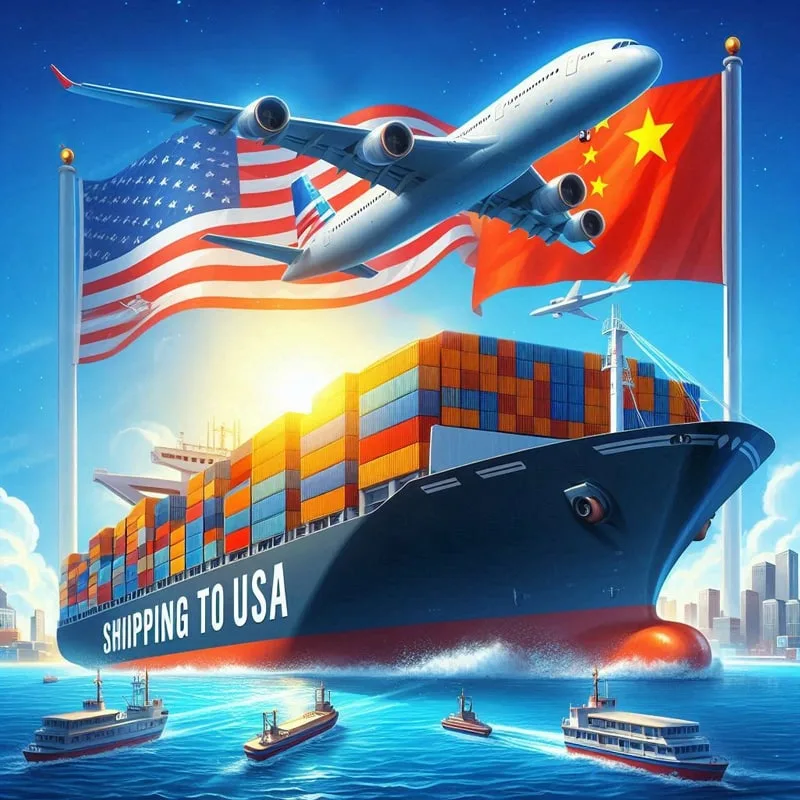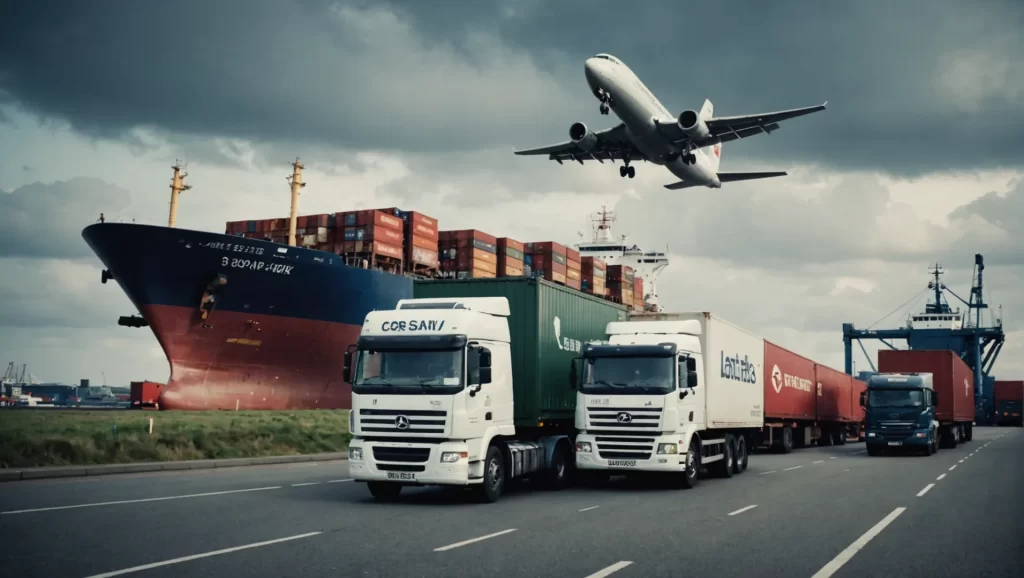- By TOP CHINA FREIGHT
- September 9, 2025
- Shipping
Table of Contents
Finding the cheapest shipping from China to USA is one of the top concerns for businesses and importers. With rising logistics costs, tight delivery schedules, and complex customs rules, choosing the right option can feel overwhelming. However, with the right strategies and freight partner, you can balance price and efficiency while ensuring smooth delivery.

What affects the cheapest shipping from China to USA?
Several factors determine overall shipping costs, including cargo weight, volume, delivery speed, customs charges, and choice of transport. Sea freight is usually the most economical for bulk goods, while air freight suits urgent deliveries. Moreover, seasonal demand, port congestion, and fuel surcharges can increase prices.
Key cost influencers include:
- Type of freight: LCL vs. FCL, express vs. standard air.
- Destination: East Coast vs. West Coast.
- Incoterms (FOB, CIF, DDP).
- Customs duties and tariffs.
- Insurance and handling fees.
By evaluating these factors early, importers can avoid hidden expenses.
Which shipping method is cheapest from China to USA?

Shipping costs vary based on method. Sea freight is usually the lowest-cost solution for large shipments, while express couriers are more expensive.
| Method | Avg. Cost (per kg / container) | Transit Time | Best For | Pros | Cons |
|---|---|---|---|---|---|
| Sea Freight LCL | $50–$80 per CBM | 25–40 days | Small-volume shipments | Affordable, reliable | Slower, possible delays |
| Sea Freight FCL | $2,000–$3,500 per 20ft | 20–35 days | Bulk cargo, high volume | Cheapest per unit, stable pricing | Port congestion risks |
| Air Freight | $5–$8 per kg | 5–10 days | Urgent medium loads | Fast, secure | Expensive, weight limits |
| Express Courier | $8–$12 per kg | 3–7 days | Small urgent packages | Door-to-door, fastest option | Highest per-unit cost |
Therefore, sea freight FCL is the cheapest when moving bulk cargo. For small, non-urgent shipments, LCL consolidation is more cost-efficient.
How do container sizes impact shipping costs?
Container choice directly impacts the cheapest shipping from China to USA. Full containers are cheaper per unit, while shared containers suit smaller loads.
| Container Type | Capacity (Approx.) | Avg. Cost China–USA | Best Use Case |
|---|---|---|---|
| 20ft FCL | 28 CBM / 10–11 tons | $2,000–$3,500 | Small businesses, heavy goods |
| 40ft FCL | 58 CBM / 22 tons | $3,500–$5,000 | Large orders, bulky products |
| 40ft HC | 68 CBM / 22 tons | $3,800–$5,200 | Lightweight, high-volume cargo |
By carefully planning volume, importers avoid paying for unused space.
What are the cheapest Incoterms for importers?
Incoterms influence costs significantly. Choosing wisely can reduce expenses.
FOB (Free on Board):
Supplier delivers to port; importer pays freight and customs. Often cheaper for experienced importers.
CIF (Cost, Insurance & Freight):
Supplier covers transport to destination port. May include mark-ups.
DDP (Delivered Duty Paid):
All costs covered by supplier, but higher prices.
For cost control, FOB with a trusted forwarder is typically the cheapest option.
How can customs affect shipping costs?

Customs clearance fees, duties, and taxes can add up. Moreover, improper documentation may cause delays and penalties.
Essential customs documents checklist:
| Document | Purpose |
|---|---|
| Bill of Lading (B/L) | Proof of shipment |
| Commercial Invoice | Declares value for duty |
| Packing List | Details cargo contents |
| Certificate of Origin | Confirms product origin |
| Importer Security Filing (ISF) | Required for USA entry |
Can air freight ever be the cheapest option?
Although sea freight is generally cheaper, air freight can be cost-efficient in specific scenarios. For high-value, time-sensitive goods, faster delivery reduces storage costs and avoids stockouts. Additionally, small shipments under 200kg may be cheaper by air compared to paying for unused container space.
Thus, while not usually the cheapest, air freight is practical when time is more critical than price.
What strategies reduce shipping costs from China to USA?
Larger volumes reduce per-unit cost
Avoid holiday surcharges
Compare rates across providers
Share containers with other importers
West Coast is cheaper for Asia shipments
Avoid customs delays
What are transit times for the cheapest shipping routes?
A medium-sized US retailer importing furniture from Guangzhou faced high costs with LCL shipments. After consulting a forwarder, they switched to a 40ft FCL, combining orders every quarter. As a result, their per-unit shipping cost dropped by 30%, and delivery schedules became more predictable. This shows that strategic planning can uncover the cheapest shipping from China to USA without compromising reliability.
What common mistakes increase shipping costs?
Importers often face higher expenses due to:
- Shipping small loads too frequently.
- Ignoring customs documentation accuracy.
- Choosing expensive Incoterms without negotiation.
- Not comparing multiple forwarders.
- Overlooking port selection.
Avoiding these mistakes ensures smoother, cheaper logistics.
Conclusion
The cheapest shipping from China to USA depends on cargo size, method, and planning. Sea freight FCL usually provides the lowest per-unit cost, while LCL and air freight suit smaller or urgent shipments. Moreover, optimizing Incoterms, shipping schedules, and customs documents significantly reduces costs. By working with a reliable freight partner, businesses can cut expenses, avoid delays, and maintain a strong supply chain.
Need a Shipping Quote?
If you want expert guidance and peace of mind, our team is ready to assist.
TJ China Freight offers tailored solutions to help businesses of all sizes ship more reliably from China.

FAQs
Q1:What is the cheapest way to ship small parcels from China to USA?
For parcels under 5kg, ePacket or economy air courier is often the cheapest choice. It balances cost with reasonable delivery time.
Q2:Can I reduce shipping costs by consolidating cargo?
Yes, consolidating shipments into one FCL or LCL load significantly reduces per-unit shipping costs compared to multiple small deliveries.
Q3:Are West Coast ports cheaper than East Coast ports?
Generally, shipping to Los Angeles or Long Beach is cheaper due to proximity. East Coast deliveries cost more but may save on inland trucking.
Q4:Do customs duties affect overall shipping costs?
Absolutely. Import duties, tariffs, and taxes add to the landed cost. Planning Incoterms and accurate declarations reduce unnecessary expenses.
Q5:Is DDP shipping always more expensive than FOB?
Yes, DDP usually includes higher supplier mark-ups. FOB allows importers to negotiate directly with forwarders, often making it the cheapest choice.
